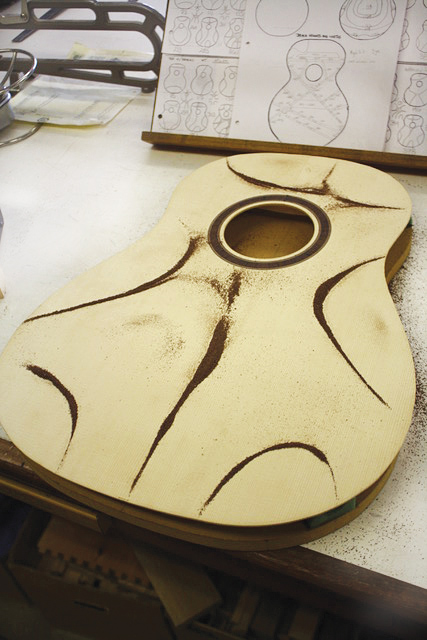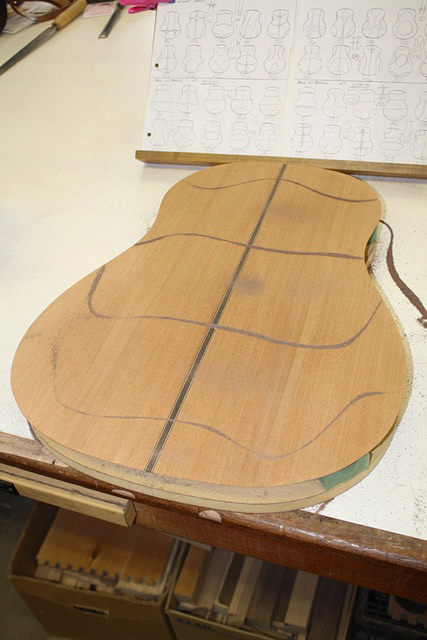
Chladni Plate Tuning
When a guitar string is plucked, the plates (The guitar’s top and back are considered the plates in this discussion) resonate, and create the familiar guitar voice. How efficiently they resonate determines the quality of that voice.
In a perfect guitar world every note, or frequency, would resonate to it’s fullest potential.
Chladni plate tuning
evolved from the great violin masters, and for
years was their exclusive domain. In the 1990’s, Al Carruth began experimenting with using
it for guitars and other stringed instruments.
Carruth developed theories
and charts showing how changing the thicknesses and graduations of
the plates also changed their resonant frequencies. He presented
lectures and workshops on measuring and controlling these frequencies, one of which was attended by luthier Mark Blanchard.
Blanchard further refined this work, applying it to his guitar building from day one.
Mark realized he had the ability to adjust the long grain and cross grain
stiffness of the plates to arrive at the desired resonant frequencies throughout the guitar’s vocal range.
I had the good fortune to meet Blanchard and play his guitars 25 years ago. It amazed me that guitars could consistently sound so good throughout their tonal range. As one of Blanchard's only students, he taught me guitar building and Chladni Plate Tuning a few years later, and I now have spent another 20 years refining this process.
I had the good fortune to meet Blanchard and play his guitars 25 years ago. It amazed me that guitars could consistently sound so good throughout their tonal range. As one of Blanchard's only students, he taught me guitar building and Chladni Plate Tuning a few years later, and I now have spent another 20 years refining this process.


I am able to
graduate and brace any top or back plate to achieve it’s
fullest potential: a guitar with a full, clear voice from it’s
lowest to it’s highest frequencies. And I can also inject unique character
into that voice.
A perfect world guitar!
All my guitars are fully documented with charts of their resonant frequencies, plate graduations, bracing layouts and dimensions. (After countless builds, the record book is THICK!) This information is a constantly evolving resource, and is referred to for all future builds. This assures both the consistency and constant incremental improvement of Randall Kramer guitars.
A perfect world guitar!
All my guitars are fully documented with charts of their resonant frequencies, plate graduations, bracing layouts and dimensions. (After countless builds, the record book is THICK!) This information is a constantly evolving resource, and is referred to for all future builds. This assures both the consistency and constant incremental improvement of Randall Kramer guitars.
Philosophy/Hand Craftsmanship
Very few of the tools and techniques that I use were invented in this century. I believe that an
heirloom-quality instrument should be built in a “timeless” fashion: by-hand. While modern CNC
machines are exacting and fast, my approach is to stay
with tried and true hand techniques.
I believe this
imparts more humanity, “soul” and individual character to
the instrument. My guitars could be considered the polar
opposite of instruments produced on a production line,
where time and cost are the overriding concern.
To me, building a guitar is all about quality, and meticulous craftsmanship. My only measuring sticks for the guitars I build are those that will impart a unique tonal character, beauty and functionality.
To me, building a guitar is all about quality, and meticulous craftsmanship. My only measuring sticks for the guitars I build are those that will impart a unique tonal character, beauty and functionality.
Materials
All woods are hand-selected for appearance, strength to weight ratio, tap tone and for
match with other components. Woods are stored in my workshop for years under perfect
humidity conditions to allow them to stabilize and cure naturally. Many wood options are available. I’ve built tops from European Spruce, Koa, Adirondack Spruce, Sitka Spruce, etc., etc. Back
and side woods offer even wider choices. I’ve used Mahogany, Brazilian or Indian Rosewood,
Myrtle, Koa, Walnut, etc., etc. Feel free to inquire about the tonal qualities and appearance of any
of these top or body woods.
Customization & Functionality
I can build using various string spacings and neck shapes, tuner types, contour cutaways, inlays,
glues, finishes (sunburst, lacquer, shellac), rosette & purfing patterns, scale lengths, soundport,
and whatever it takes to make your guitar right for you.
One thing that is somewhat unique about my building is the compound radiusing of my fretboards. The radius begins at 12” or 14” at the nut and transitions to 20” at the sound hole. (In laymen’s terms: the fretboard is more arched across its width at the nut and gets progressively flatter as it descends toward the body of the guitar.) Thus, as the spacing between strings widens from the nut to the bridge saddle, the strings maintain a constant height off of the fingerboard. This compound radiusing is one of the places where I incorporate a modern element to my builds in a subtle nod to the functionality and playing comfort desired by most players. The vast majority of guitars, including Martin and Gibson, have fretboards with a simple single radius.
For more information, use the contact form.
One thing that is somewhat unique about my building is the compound radiusing of my fretboards. The radius begins at 12” or 14” at the nut and transitions to 20” at the sound hole. (In laymen’s terms: the fretboard is more arched across its width at the nut and gets progressively flatter as it descends toward the body of the guitar.) Thus, as the spacing between strings widens from the nut to the bridge saddle, the strings maintain a constant height off of the fingerboard. This compound radiusing is one of the places where I incorporate a modern element to my builds in a subtle nod to the functionality and playing comfort desired by most players. The vast majority of guitars, including Martin and Gibson, have fretboards with a simple single radius.
For more information, use the contact form.
